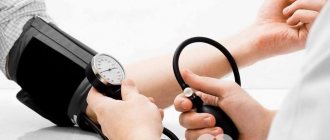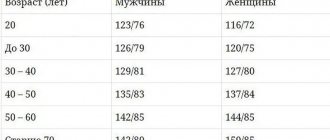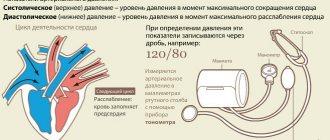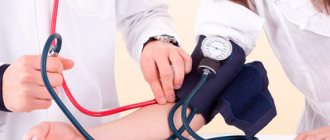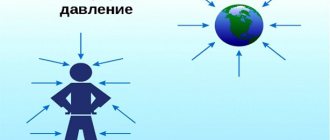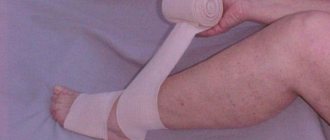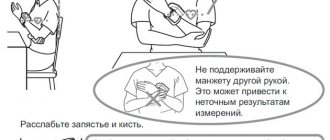What pressure is considered normal?
Blood pressure levels vary depending on age, health status and other factors affecting the human body.
Human blood pressure: age indicators
In a healthy adult, approximately the following indicators are considered normal::
- up to 40 years – 125-130/80 for men, 120-125/80 for women;
- up to 50 years – 130-135/85 for men, 130-135/85 for women;
- up to 60 years – 139/85 in men, 139/85 in women;
- 70 years and older – 140/89 in men, 140/89 in women.
For children, the normal systolic pressure can be calculated in this way:
- children under one year old – 76 + 2 x N (where N is the child’s age in months);
- children over one year old – 90 + 2 x N (N in this case is the number of full years).
Diastolic pressure is calculated as follows:
- children under one year old - 2/3-1/2 from the upper limit of normal systolic pressure;
- children over one year old – 60 + N.
In turn, the upper limit of the norm is determined as follows::
- systolic – 105 + N;
- diastolic – 75 + N.
Mechanical tonometer for measuring blood pressure included
Bottom line:
- systolic – 75 + 2 x N;
- diastolic – 45 + N.
Although there are accepted blood pressure standards, it is still recommended to build on your individual normal values, the so-called “working” pressure. To know your blood pressure, you need to measure it at rest.
How to determine your own pressure
In order for one to understand how to use a mechanical tonometer, you should remember that when measuring your own pressure, you need to simultaneously release air, follow the pressure gauge needle and listen to the tones. This requires a certain skill and may not work out the first time. However, short training will help you carry out the procedure quickly and obtain highly accurate results.
So, at first the arrow will move slowly, but there will be no sound. Then a strong tone will appear, the strongest sound will indicate systolic pressure.
Gradually (the speed depends on the speed of deflation of air), the rhythmic tones will begin to fade, and the arrow indicator on the minimally distinguishable sound is the diastolic pressure. For example, if the sound appeared at 145 mm. mercury column, and disappeared at 80, then, accordingly, the pressure readings will be 145/80.
You can take no more than 2 measurements in a row. If you are not sure of the accuracy of the result, take a half-hour break and repeat.
You should not measure blood pressure after you have climbed the stairs or have become too nervous. And even more so to diagnose yourself.
How to measure blood pressure correctly
Measurements are usually taken on the left hand, but this is the case if the person is right-handed. Therefore, in order to obtain the most accurate results, this factor must always be taken into account.
The most difficult way to measure blood pressure is with a manual tonometer. Working with such a device requires some skills. But this device is more practical and reliable, since its operation does not depend on battery charge.
A mechanical tonometer consists of a bulb, which is attached to a cuff using a rubber tube. The same element is attached to the monometer. Also included is a phonendoscope, with which you can listen to the sound manifestation of the indicators.
Pressure measurement process:
- The cuff must be placed on the forearm. The area should be selected so that it is two to three centimeters higher from the elbow.
- The cuff should fit tightly around the arm and be secured with Velcro.
- The hearing part of the stethoscope is inserted into the ears, and the membrane amplifier is applied to the inside of the limb, in the area where the pulsating artery is located.
- Next, you should check that the meter needle is at zero. If this is not the case, it means that there is air in the cuff (you need to deflate it all the way) or the determiner is broken (in this case it will not be possible to measure correctly).
- After this, you need to tighten the valve on the bulb, thereby preventing air from escaping during injection.
- Then you need to inflate the cuff by repeatedly squeezing and unclenching the bulb. This must be done until the arrow on the monometer becomes higher than the expected number. It is recommended to choose this indicator based on previous measurements.
- After this, the air pumping must be stopped and the valve on the bulb must be slowly unscrewed.
- The arrow on the screen will gradually move down. She should be monitored closely.
- The first knock that appears in the auditory part of the phonendoscope is an indicator of upper pressure.
- A clear tone will be heard for a while. Then it will begin to subside. The moment when the sound disappears completely and is indicated by the number of the lower, that is, diastolic blood pressure.
- The air from the cuff must be completely deflated and you can remove it from your hand.
It is much more convenient to take measurements using automatic and semi-automatic partings. They don't require much practice.
Anyone can handle such devices. You can choose an electrical device for the forearm and hand.
An automatic tonometer is a device consisting of a cuff and a display. It also needs to be put on the hand, but that’s where all human participation ends. He himself pumps the air to the required levels and releases it himself. The final results are displayed on the screen. The disadvantage of this device is that it can only measure if it has batteries. And if the batteries do not have sufficient charge, errors in the indicators are possible. If you decide to choose such a device, you will need to regularly monitor the condition of the charging elements.
The operating principle of a semi-automatic tonometer is partly similar to an automatic device. It also records the numerical results of systolic and diastolic blood pressure without assistance, but cannot pump air on its own. To do this, there is a bulb through which you need to pump it into the cuff with your own hands. Further, the electrical mechanism itself records the numerical indicators at which the artery straightens (based on changes in air pressure in the cuff).
It is preferable to measure blood pressure at home. This is due to the fact that in a familiar environment a person is more relaxed and does not experience the stress that can be observed in a hospital.
Author of the article: Kristina Borisova
How to pump air correctly
The instructions for the device will also tell you how to use a mechanical tonometer. Look at her, she will be a good helper. After the cuff is fixed, you need to pump air into it using a special bulb (in the instructions it is called an air blower).
First, screw the clamp on the bulb (air release valve) all the way, and then pump air into the cuff with your other hand (not the one you are measuring on). In this case, the needle on the pressure gauge should show a pressure higher than your usual by about 40 units. For example, if the pressure is usually 120/80, then the needle needs to reach 160 mmHg. Then slowly release (unscrew) the air valve.
Schedule and technique for measuring blood pressure
How to measure pressure with a tonometer in such a way that you can determine a person’s daily blood pressure profile? After all, hypertensive patients and people with heart disease should very carefully monitor changes in this indicator. A more accurate idea of the state of the heart muscle will be obtained by performing the procedure in question multiple times throughout the day. The first time the pressure is measured early in the morning, 1 hour after waking up. The second indicator is recorded 1 hour after lunch. The best hours for evening measurements are 19:00-20:00.
You need to prepare a little before measuring blood pressure. Here are some conditions that must be met in order for automatic blood pressure monitors to show reliable results:
- The last meal should take place at least 2 hours before the procedure;
- Smoking, drinking alcohol and caffeinated drinks are prohibited;
- Before the procedure, vasoconstrictor drops and sprays should not be used;
- before measuring blood pressure, a person must exclude any types of physical activity, and if there is any, they must rest for half an hour;
- during the procedure itself, a person should not strain his muscles, talk, laugh or worry - all this can significantly distort the results;
- If before the procedure a person was exposed to cold or extreme heat for a long time, at least an hour should pass before measuring blood pressure.
Reliable results can only be counted on if all of the above conditions are met.
Moreover, we should not forget about the stress received by the body during the procedure. It is the latter that can become several tens of mmHg. Art. As mentioned above, the technology for using advanced new devices is somewhat different from that described. If all conditions are met before the measurement procedure and the cuff is correctly positioned on the arm, the device will do almost all the work on its own. After the start of the procedure, after some time the results will be displayed on an electronic display. Tonometer models developed over the past year have a built-in memory function that allows them to remember and save results.
Interpretation of the results obtained
It is recommended to determine blood pressure twice a day, morning and evening, or if an atypical situation occurs (intense headache, dizziness, flashing luminous spots before the eyes, ringing in the ears, unsteadiness when walking, etc.).
According to modern concepts, the optimal blood pressure is less than 120 (systolic) and 80 (diastolic) mm Hg. Art. If the pressure numbers are often or constantly fixed at values of 90 and 60 mmHg. Art. and below - this phenomenon is called hypotension and requires consultation with a cardiologist.
In the process of determining blood pressure, it is necessary to remain motionless, not talk, or change the position of the hand.
Pressure in the range of 120–129 and 80–84 mmHg. Art. is regarded as normal, and in the range of 130–139/85–89 mm Hg. Art. – as normal high or prehypertension.
If normal high blood pressure is regularly recorded during measurements, this is a reason to contact a specialist. In this case, there is a high risk of developing hypertension. A therapist or cardiologist will tell you how to protect yourself from developing the disease.
Pressure more than 140 and 90 mmHg. Art. is a manifestation of arterial hypertension - a serious cardiovascular disease. If such numbers are systematically recorded in the morning after a night's sleep or at rest against the background of psycho-emotional well-being, you should contact a cardiologist. Also a reason for consulting a specialist is an abrupt increase in blood pressure during stress, neuropsychic stress, and physical exertion.
Preparing for measurement
Measuring blood pressure requires compliance with important rules and recommendations. Often patients refuse an electronic tonometer due to the discrepancy between the indicators and a mechanical device. However, this is a misconception among many. If the patient fulfills the requirements, the results of blood pressure measurements can be considered reliable.
So, to obtain accurate blood pressure readings when using a digital tonometer, you need to adhere to the following rules:
- Correct cuff size. In length - at least 80%, and in width - at least 40% of the arm circumference. An incorrect cuff size will distort blood pressure measurements.
- Cuff application. Its location should be even, distortions should not be allowed, and it should not be too loose or too tight in girth.
- Peace of mind while taking measurements. Maximum peace of the patient's body and emotional state ensures the accuracy of the results of the procedure.
- Refusal to carry out preliminary power loads and procedures. 1 hour before measuring blood pressure, you should avoid taking a shower or bath, as well as high physical activity and emotional outbursts. The accuracy of the results is also affected by the strong tea and coffee you drank before.
- Emptying the bladder. If the bladder feels full, it needs to be emptied, since pressure in the organ increases blood pressure.
- Limitation of movements. During measurements, the patient must remain motionless, not gesticulate with limbs, or engage in dialogue.
- Before measuring, sit quietly for 5-10 minutes.
- Abstain from alcohol and cigarettes for 1.5-2 hours.
The accuracy of the results depends on proper preparation for using the tonometer.
Advice. If the device operates normally, but at the same time shows different indicators, it is necessary to submit it for testing to the appropriate metrological center. When using the device at home, it is recommended to have it checked every 3 years.
Blood pressure is a variable indicator. It depends on a number of factors. Therefore, both in patients diagnosed with cardiovascular diseases and in completely healthy people, it can change several times during the day. The main factors influencing blood pressure indicators are:
- power loads;
- psycho-emotional state;
- weather;
- time of day (at night the pressure is much lower than during the day);
- nutrition.
If a patient measures his blood pressure several times a day and notices fluctuations, this is a natural, normal factor. The appropriate period for manipulation is the period of stabilization. Doctors advise taking measurements in the morning and before bed. Only these data can be considered objective, on which drug therapy can be based.
Correct posture
The patient's body position is the main criterion. It affects the accuracy of the results. Let us immediately note that measurements cannot be taken while standing or lying down. The most correct indicators will be if the patient takes a sitting position.
The recommendations will be as follows:
- Choose a comfortable position on a chair, leaning against its back.
- You can't cross your legs.
- Place the hand on which measurements will be taken on a flat surface, until it is completely relaxed. It is strictly forbidden to hold the upper limb suspended or lower it down.
- The hand should be at heart level.
- Ensure a stationary sitting position and do not engage in dialogue with anyone.
- Before the procedure, it is advised to take deep breaths and exhales several times, this allows you to restore blood flow and normalize your heart rate.
The pressure measurement procedure takes place in a sitting position.
Which hand should I measure on?
According to the recommendations of medical specialists, pressure should be measured on the “non-working” arm. That is, if a person is right-handed, then the pressure is measured on the left limb; if a person is left-handed, the opposite is true. At the same time, we note that reliable blood pressure data can be measured by measuring on both arms; the manipulations are repeated several times in a row. The interval between measurements is 5-10 minutes, so the average result is obtained, which the doctor relies on when prescribing treatment. The average is calculated by recording the results obtained over several days in a notebook, where the stability of the indicators of each hand will be visible. Subsequently, it is recommended to measure the pressure on the arm where the readings will be more stable.
Preparation
To correctly measure pressure with a mechanical tonometer and obtain reliable results, you must follow the preparation recommendations before the procedure. If a patient climbs the steps to the third floor of the clinic and immediately enters the office to measure blood pressure, the readings will be greatly inflated. This may confuse the attending physician. Simple tips will help you avoid this.
Preparation rules before measurements:
- Immediately after eating, the tonometer may show unreliable results, so at least 30 minutes should pass after eating.
- If you know in advance that you are going to measure your blood pressure with a mechanical or electronic tonometer, 3 hours before you need to stop consuming caffeine-containing products, drugs that affect the vascular system, alcohol-containing and energy drinks, and smoking. All these factors change blood pressure readings.
- The emotional state greatly influences the numbers displayed on the tonometer. 10-15 minutes before the measurement it is better to calm down and not be nervous.
- Any physical activity increases vascular tone. To measure blood pressure correctly, you need to spend 5-10 minutes before the procedure in complete rest, taking a comfortable position on a bench, couch or chair.
In emergency cases, when there is no time to prepare, it is recommended to calm down as much as possible and sit for at least 3-5 minutes or, if possible, lie down without unnecessary movements, without talking. This will slightly reduce vascular tone in order to obtain more accurate tonometer readings.
How to measure your blood pressure with a manual tonometer video
Hypertension is the scourge of a civilized society; every third person suffers from it after the age of 40. Therefore, in order to independently regulate blood pressure, it would be useful for everyone to learn how to measure it for themselves and their loved ones.
Mechanical tonometer
Advantages of a mechanical tonometer
Therefore, both the general practitioner called to your home and the ambulance paramedic will most likely use a mechanical device.
The advantages of such a device:
- has a simple design;
- allows you to measure pressure with maximum accuracy;
- rarely fails;
- does not require battery replacement;
- suitable for hands of any size, including children’s;
- lasts longer than electronic ones;
- affordable.
Hand-held device
A manual tonometer for measuring pressure is an air-filled cuff with Velcro, connected by hoses to a rubber pump - a bulb and a meter (manometer). The cuff is wrapped around the patient's shoulder and fastened. The bulb is equipped with a screw-on valve. By compressing it several times, air is pumped into the cuff.
In addition, some devices come with a phonendoscope for listening to blood impulses in the arteries. These blood pressure monitors are certainly more convenient.
Types of mechanical devices
Manual mechanical tonometers are produced by various manufacturers. The variety of models allows a person to choose a device in accordance with his wishes and financial capabilities. The table below shows examples of the most popular mechanical devices.
| Manufacturer | Microlife, Switzerland | B.Well, UK | Little Doctor, Singapore | Rudolf Riester, Germany |
| The presence of a phonendoscope in the kit | No | Eat | No | Eat |
| Measurement error, mm Hg. Art. | ±2 | ±3 | ±3 | ±3 |
| Cuff dimensions, cm | 14.5 x 53 | 25–40 | 14 x 53 | 54.5 x 14.5 |
| Device weight, g | 360 | 385 | 237 | 390 |
Preparing to measure blood pressure
The manipulation should be performed in a relaxed state, calmed down and not nervous. To reduce the likelihood of receiving erroneous results, you need to properly prepare for measuring pressure:
- At least 2 hours before the procedure, give up coffee, alcohol, smoking, and medications that act on blood vessels.
- Do not undergo significant physical activity before taking measurements.
- Immediately before the procedure, empty your bladder.
- You can measure your blood pressure 30 minutes after eating.
When to measure
There is a certain schedule according to which you can measure your blood pressure yourself. The first measurements are taken with the device in the morning. Before this, you should not eat heavy food, drink a lot of coffee-containing drinks, drink alcohol, smoke or take a hot shower. Then the blood pressure is checked in the evening. This will allow you to compare the clinical picture. You can also measure your blood pressure using a bulb, depending on how you feel. For example, there is dizziness or weakness. Without complaints, it is enough to check your blood pressure with a blood pressure meter once every 2 days. It is advisable to write down all the results in a notebook so that the doctor knows the whole picture of the pathology. If the procedure is performed frequently, fragility of blood vessels, lymphatic congestion and swelling may develop.
Measurement errors
For the accuracy of the results, it is necessary to exclude all external as well as internal factors that change the final result. Therefore, the measurement is carried out in complete peace, comfortable conditions for humans.
- Incorrect preparation for the procedure. The last consumption of strong caffeine-containing, alcoholic, and energy drinks should occur no later than an hour before the procedure. Serious physical activity should be completed 2 hours before, and meals should be completed half an hour before measurement.
- Pressure is measured in a sitting position, with the torso resting on the hard back of a chair. The arm needed for research should be bent and lie on top of the table, resting on the elbow. The general condition of the subject is relaxed, without gesturing or talking.
- Rolling up of the sleeve, incorrect placement of the cuff. It should be placed on the forearm 2-3 cm above the bend of the elbow. This will bring the compression zone closer to the level of the heart. Conductive air ducts should be placed along the inner surface of the arm from the elbow to the hand.
- Bleed air speed. If the valve is opened too far, the first beat (tone) will be difficult to hear. Therefore, it is worth doing this smoothly at a rate that is 10-20 points higher than usual, without increasing the air discharge rate until the upper and then lower values are accurately established.
- Frequency of repeated measurements. To obtain an accurate result, it is recommended to perform three consecutive blood pressure measurements, with an interval of 3-5 minutes. During this time, the blood flow manages to restore the vessels narrowed by air injection. Therefore, the time interval between approaches cannot be reduced.
. Next, it is carried out on the hand where the indicators are higher.
Recommendations
Often people do not know how to use a manual blood pressure monitor or a semi-automatic device. Let's look at some recommendations:
- People over 40 years of age are recommended to purchase automatic blood pressure monitors; devices on the wrist will not accurately reflect the readings, since the arteries in this area are quite worn out in older people.
- For patients suffering from cardiovascular diseases, it is better to purchase a tonometer that measures not only blood pressure, but also pulse.
- If the device is used by two family members, you should pay attention to models that store the data of two users.
- A tonometer with a fan-shaped cuff does not cause discomfort during use; it fits tightly to the arm, as a result of which blood pressure readings are not distorted.
- The cuff must not be secured over clothing or the device must be turned on until it is worn.
- During the procedure, you should not talk or strain.
- For people with poor vision, tonometers have been developed that pronounce the measurement results, and devices with an intelligent control function are also commercially available. Thanks to special sensors, they give a signal if the procedure is performed incorrectly.
In the article we looked at how to use a tonometer. It is worth saying that the correctness of the noted indicators depends on the correct use of the device. If a person is in doubt, then it is necessary to talk with a doctor and clarify the nuances of using a tonometer.
Features of measuring pressure with a mechanical tonometer
Each person could see how to do it correctly when undergoing a medical examination.
The procedure is quite simple and takes no more than 5 minutes. The obtained indicators are influenced by the patient’s age, weather, the presence of pathologies and body position, therefore small deviations from the norm within 10-15 units are allowed. It is quite simple to understand how to measure your own blood pressure using a mechanical tonometer if you familiarize yourself with the following algorithm of actions:
- Sit comfortably on a chair, straightening your legs, leaning completely against its back and placing your hand on the table, bending it at the elbow. The limb should remain at chest level to obtain the most accurate readings. It is first necessary to free her from clothing so as not to further compress the artery.
- Place the cuff just above the elbow (around the forearm). It is important that there is no air in it. Otherwise, the obtained values may differ slightly from the true indicators. The cuff should be tightened, but not too tight. If it hangs freely on your arm, then low pressure will be recorded. Otherwise, the indicators will be overestimated and the person will experience discomfort during the procedure due to pinching of the limb. You can tell that the cuff is on correctly by inserting 2 fingers under it. If the manipulation is difficult, but realistic, then everything is correct.
- Find the brachial artery slightly above the elbow and apply a sound membrane to it. It is not advisable to hold it with your thumb. It will reflect its own pulse, which will interfere with listening to tones. Experts advise fixing the stethoscope head with your index or middle finger. It is equally important to place it slightly below the edge of the cuff so that additional noise is not created.
- After checking that the cuff is securely fastened and leaning the sound membrane to the desired place, take the pear with the other hand. Close the valve firmly (clockwise) so that air does not escape during the pumping process.
- Start pressing hard on the pear. The cuff will inflate, thereby compressing the artery. Continue the process until the readings on the pressure gauge screen are 160-180 mmHg. Art. Then open the valve on the bulb slightly so that air begins to escape from the cuff. Its speed should not exceed 1-2 units to successfully record values.
- While releasing air, try to hear the first tone. It is the upper (systolic) threshold, which shows the force of blood pressure on the vessels at the moment of cardiac contraction.
- Gradually the noise will increase. Having reached its maximum, it will begin to subside. The last tone heard is the lower (diastolic) threshold. It shows the force of blood pressure during complete relaxation of the heart muscle.
- Indicators equal to 120/80 (+-10-15 units) are acceptable. If the pressure is higher or lower than normal, then after 3 minutes you will have to measure again. If a negative result is confirmed, it is recommended to consult a doctor.
Having figured out how to measure blood pressure without leaving home, you can protect yourself from the development of hypertension or hypotension by periodically using a tonometer. To obtain more accurate data, it is advisable to remember the following tips:
- When measuring the blood pressure of a large person, problems often arise with the size of the cuff. The forearm may be too large. In this case, you will have to purchase a device specifically for the individual characteristics of the structure or go to the hospital for measurements. For kids, the situation is exactly the opposite. Their hand is too small, so they will have to buy a child cuff.
- When performing the procedure on yourself or another person, you must remain silent and turn off third-party devices that make sounds in order to hear the tone.
- Before repeating the measurement, at least 3 minutes must pass. The hand was pinched, so it takes time for it to return to normal. Otherwise, the indicators will be overestimated.
- For convenience, the pressure gauge can be hung on clothing when taking measurements for another person or placed on the table in front of your eyes.
Algorithm of actions
Using simple measurement rules allows you to learn how to measure your own blood pressure without any problems.
If you are starting to control your blood pressure for the first time, you need to remember the following:
- The first measurements are always taken on both hands.
- If the readings do not differ, the pressure should be measured on the non-working arm. Accordingly, for right-handers it is the left, and for left-handers it is the right.
- For different values, further measurements are taken on the limb where the value is higher.
Keep a special diary where daily indicators are recorded. If they differ by more than 5 mm. rt. Art. - repeated measurements are taken. It is necessary to carefully monitor the division scale and learn to find average values.
The most reliable types of devices are mechanical, equipped with a cuff with a “pear” for pumping air and a phonendoscope. Such devices have a simple design, low cost and are affordable for most buyers.
Anyone can measure blood pressure using a manual tonometer; to do this, you need to follow a simple algorithm of actions:
- Place the cuff over your shoulder and fasten it so that your thumb fits underneath it. The lower border should be 2 cm above the level of the elbow bend.
- Place the stethoscope in the cubital fossa so that you can clearly hear the pulsation of the artery.
- Tighten the valve and start pumping air into the bulb until the pulse stops, pumping up another 20 mm. rt. Art. Then slowly open the valve.
- Listen to the pulsation and look at the built-in meter - the first sound in the phonendoscope corresponds to the upper blood pressure readings. At the moment the tones disappear, the lower blood pressure number is noted.
The sounds you hear through a phonendoscope are called Korotkoff sounds—there are five of them, and they are valuable to doctors in diagnosing heart disease. When measuring pressure, only the first (strongest) and last (quiest) noise is important - they show the upper and lower limits of blood pressure.
This method is very common - the so-called Korotkoff tonometers allow you to measure blood pressure manually and are widely used in hospitals and among the population.
How to measure blood pressure in children?
Manufacturers produce many children's devices that allow you to measure blood pressure even for newborn babies.
Usually these are automatic or semi-automatic blood pressure monitors that record blood pressure numbers independently, because young children cannot always behave calmly during the procedure, which reduces the accuracy of measurements. Therefore, it is better to use devices equipped with electronic equipment that do not require a phonendoscope.
The main difference from the adult measurement is the cuff size.
For this purpose, it can be purchased separately, guided by the age of the child:
- For newborns, the circumference is 5-7.5 cm;
- For infants, a cuff from 7.5 to 13 cm is suitable;
- For older children – 13-20 cm.
If it is not possible to purchase a cuff, you can use a wrist tonometer, but fasten it not on the wrist, but in the shoulder area. During measurement, you can distract your baby with verbal games or fairy tales. If necessary, the child can be placed on the mother’s lap.
How to measure blood pressure without a phonendoscope?
If you have an old tonometer that does not have a stethoscope, you can take measurements without it. To do this, place your fingers on the radial artery (where the pulse is usually felt), releasing air from the cuff, note the moment the pulse appears - this will be the top number of blood pressure. It is impossible to measure lower (diastolic) pressure in this way.
The main landmark is the pulsation of the radial artery above the wrist. The step-by-step procedure is similar to the classic scheme for using a manual tonometer. While following the arrow, you need to note the beginning and end of the pulse - these are the boundaries of the upper and lower blood pressure.
It is important to note that this test is considered incorrect and inferior to traditional measurement - it can be used to temporarily record blood pressure readings.
Blood pressure measurement
The pressure will return to normal! Just remember once a day.
The procedure for measuring pressure using a mechanical tonometer boils down to the following steps.
- It is necessary to take a comfortable sitting position, and the hand on which you plan to measure blood pressure is placed on a stable surface somewhere at the level of the heart and relaxed.
- You need to put the cuff on the upper limb just above the elbow (approximately 2 cm) and fasten it with a Velcro fastener.
- Next, insert the phonendoscope olives into the ears.
- Then the membrane amplifier of the phonendoscope is applied to the inner area of the elbow joint where the pulsating vein is located.
- Then you need to close the air release valve located in close proximity to the bulb and inflate the cuff.
- It is necessary to stop when the pressure gauge shows a value exceeding the normal operating indicator of upper pressure characteristic of a particular person.
- Next, you should stop inflating the cuff and slowly open the bulb valve, trying not to miss the initial impulse of blood, listening with a stethoscope - this is the value of systolic pressure (upper pressure).
- When the clear pulse rhythm subsides, the diastolic pressure indicator is noted - that is, the lower pressure.
- Upon completion of the measurements, all air should be released and the cuff should be removed from the upper limb.
Most people anticipate changes in blood pressure based on their own feelings
However, it is important to remember that a jump in blood pressure may go unnoticed if it is asymptomatic. This is why it is better to measure your blood pressure if you notice facial flushing or sudden throbbing in your temples, or when you feel dizzy
Often such signs are discovered after work overstrain or an unpleasant conversation, since stress and a jump in blood pressure are inseparable companions. However, pressure can increase due to atmospheric changes, increases in temperature, as well as due to changes in body posture or due to excessive physical activity.
For prevention, as well as in the above conditions, blood pressure should be measured in absolutely healthy individuals.
And if a person suffers from hypertension, diabetes, kidney disease and endocrine diseases, then the device should be used systematically (twice a day - morning and evening). In the morning, indicators are taken from both upper extremities, due to which sclerotic phenomena are detected in the vessels of the arms. Measurements are taken in the evening after taking all medications, in a relaxed state.
As a rule, the arterial norm for a healthy person is 120/80. However, deviations also occur, which are often known to the patient. Often they affect the upper limit of values. But the worst option is considered if the upper and lower blood pressure values are closer. Blood pressure is systematically monitored in pregnant women. It must be remembered that low blood pressure is no less dangerous in its manifestations. That is why symptoms such as weakness, drowsiness and staggering in an upright position should be a signal to check your blood pressure readings.
Even children are susceptible to problems with low and high blood pressure, so if your child complains of dizziness or headache, it would also be useful to measure the pressure.
Such symptoms may be a manifestation of a hidden disease. However, you need to remember that the cuff for a baby should be narrower, shorter and appropriate for his age.
Many of our readers actively use a well-known method based on natural ingredients, discovered by Elena Malysheva, to TREAT HYPERTENSION. We recommend that you check it out. Read more.
How to measure wrist pressure?
A tonometer that allows you to measure pressure on the wrist is in great demand among hypertensive patients. The device is portable, has a modern design and stores all blood pressure indicators for a long time.
How to use a wrist blood pressure monitor:
- The tonometer is placed on the arm with the display facing up. There should be a gap of 1 cm from the bottom edge of the bracelet to the palm. There is no need to tighten the strap too much, but the bracelet should fit evenly to the hand.
- The patient takes a comfortable position and places his hand in front of him at heart level. Then you need to even out your breathing and relax. The device is activated; you cannot move during the measurement.
Typically, blood pressure readings measured at the wrist are slightly higher than those obtained from the same procedure at the forearm. Manufacturers of devices do not hide this and explain it by the specific location of the arteries on the wrist and their width.
Common mistakes
Very often, when measuring blood pressure with a mechanical tonometer, people make a number of mistakes. As a result, the data obtained is incorrect. Therefore, you need to know how to correctly measure blood pressure at home. A person can make a number of common mistakes.
Incorrectly fitted cuff
There are devices with a wrist cuff. But such devices have a number of limitations - they are not recommended for use by obese people and patients over 45 years of age. If a tonometer is purchased for the whole family, it should have a shoulder sleeve.
Wrong cuff size
This is a fairly common mistake that occurs when using a tonometer at home. The size must be selected according to the person's shoulder circumference. If the cuff is too long, this will lead to an underestimation of blood pressure; if it is too short, this will cause it to be overestimated. To determine blood pressure correctly with a mechanical tonometer, the length of the inflating part of the cuff should be about 80% of the patient’s upper arm circumference. And the width of the cuff of the measuring device should be approximately 12-14 cm. Typically, the device includes a sleeve designed for the average adult. Children and obese people may need to purchase an additional cuff.
Incorrect cuff size is one of the most common mistakes when measuring blood pressure with a mechanical tonometer.
Incorrect body position
Pressure must be measured at the level of the heart muscle. If the cuff is higher, the readings will decrease, and if higher than the level of the heart, they will increase. The person must be in an upright position. The doctor may recommend that the patient lie on his back, but the limb should rest against the table and be vertical.
Incorrect cuff application
It should not be placed on top of clothing. Sweater, jacket - all this must be removed, otherwise the data obtained may be incorrect. But a thin shirt should not affect the final result.
Too frequent measurements
You cannot measure pressure several times in a row on the same arm. After the first compression, the vessels can adapt to decompression. Therefore, in the future the device may show different results. Therefore, the interval between measurements should be at least 7-8 minutes.
Thus, you can use the tonometer at home. But this must be done correctly, otherwise the device will produce incorrect results. During the procedure, a number of rules and recommendations must be taken into account.
The right time
The attending physician may recommend that the patient keep a blood pressure diary to find out the full clinical picture. To do this, at home, in compliance with the rules for using a tonometer, you need to independently measure blood pressure several times during the day. The readings should be written down in a notebook or on a piece of paper so that the doctor can see the dynamics.
The right time for the first measurement is in the morning, 1 hour after sleep and breakfast. Before this, you should not smoke, drink coffee or other tonic drinks. In the evening, you need to repeat the procedure to determine the dynamics of blood pressure during the day.
In the middle of the day, if you feel unwell, you can measure your blood pressure again and write down the readings, noting the reason for unscheduled tonometry (headaches, weakness, nausea, dizziness). We must not forget that using the device too often unnecessarily is unacceptable. This leads to false results and impaired blood circulation in the vessels of the hand.
The best semi-automatic blood pressure monitors
There are many models of semi-automatic tonometers, so choosing is often difficult. You can pay attention to the following devices. Users respond positively to them; they are in great demand in stores and pharmacies.
Little Doctor LD-22
This is a fairly budget model, the cost of which is only 1.5 thousand rubles. But in terms of quality, it is in no way inferior to more expensive devices; it simply does not have additional functions besides measuring blood pressure and pulse rate.
This tonometer is suitable for people over 15 years of age. The size of its cuff is 25-37 cm. Therefore, it is suitable for both thin and overweight patients.
LD2
This is also an inexpensive model, which costs about 1.5 thousand rubles. The device is very convenient, helps to accurately determine blood pressure and pulse rate readings. It has a cuff whose size is 25-35 cm.
The device is equipped with only basic functionality; there are no additional options. Therefore the cost is low. The semi-automatic tonometer operates on removable batteries. They are enough for about a thousand measurements.
LD2 - inexpensive and compact automatic tonometer
B.WELL WA-22H
This model of semi-automatic blood pressure monitor will cost the buyer approximately 1.7 thousand rubles. Its difference from many semi-automatic machines is that it can operate from the network, and not just from batteries. This is already a big plus for users, although the network adapter will have to be purchased separately.
The device has the longest cuff, so it is suitable for patients of both thin and heavy build. The device has a basic set of functions: you can measure blood pressure, determine pulse rate, and save results.
It is worth noting that this model has a large display and large numbers, so it is suitable for people with visual impairments.
Nissei DS-137
A good model of a tonometer, the cost of which is about 2 thousand rubles. The device has a fairly large display, which is ideal for older people with poor vision. The device measures blood pressure, checks pulse, and allows you to save measurement results.
The kit includes a cuff measuring 22-32 cm. The tonometer runs on four batteries.
Microlife BP A50
You can purchase this model for 1.5 thousand rubles. The device copes well with its main task – measuring a person’s blood pressure. It also determines the heart rate and saves the measurements taken.
This tonometer differs in that it is able to recognize when a person experiences surges in blood pressure. The cuff of the device has a standard size. The device operates on batteries.
Microlife BP A50 – Swiss quality at an affordable price
A&D UA-705
This is already a more expensive model, which can be bought for about 2.3 thousand rubles. It has the most advanced functionality. In addition to measuring blood pressure, the tonometer determines the pulse rate, recognizes heartbeat signals and arrhythmia. Measurement results can be saved.
The kit includes a cuff that measures no more than 32 cm.
TENSOVAL COMPACT
The cost of such a model is about 2 thousand rubles. The tonometer is of high quality, works for a long time without failures, and has an attractive design. It has no additional functions, only measuring blood pressure and pulse.
The device is designed for two users. But at the same time, only one memory cell is allocated for each of them. The device runs on batteries. They are included in the kit. Their charge lasts for a year of use. The cuff has a universal size.
OMRON M1 Eco
The cost of such a model is about 2 thousand rubles. It helps in measuring blood pressure, determining pulse rate, and recognizing disorders in the functioning of the heart and blood vessels. The device also allows you to save the obtained blood pressure readings.
The device includes additional cuffs so that you can measure blood pressure for both adults and children. When used, the tonometer itself notifies the person that there is enough air in the cuff to measure blood pressure.
Semi-automatic blood pressure monitor OMRON M1 Eco is suitable for use by the whole family
OMRON M1 Compact
The list of budget semi-automatic blood pressure monitors is supplemented by this model. It costs about 1.5 thousand rubles. A good device that perfectly performs its functions of measuring blood pressure and determining pulse rate.
It is possible to save test results. The cuff size is standard, so it is intended only for adults.
OMRON S1
The cost of this tonometer is 1.3 thousand rubles. Measures blood pressure accurately and helps you know your pulse. You can save test results. The tonometer has only basic functions, there are no additional features.
The cuff size is universal. To operate the device, you will need to purchase batteries; it does not operate on mains power.
Which hand to measure on
Questions often arise: on which arm is pressure measured? The primary task for the first measurement is to select the limb for subsequent measurements in the future. Each arm is measured up to 10 times with a 5-minute break, and all results are recorded. Then the minimum and maximum values should be crossed out. For subsequent measurements, the arm with the highest blood pressure readings is used.
It is generally accepted that a right-handed person has higher pressure on the left hand. Accordingly, the left-handed indicators are higher on the right limb. This may also be a determining factor when choosing a hand for measurements.
How to use a mechanical and electronic blood pressure monitor
Modern manufacturers of medical equipment market electronic and mechanical blood pressure monitors that perform the same function, but differ from each other in design and method of determining blood pressure.
Regardless of the device chosen, before taking measurements, it is necessary to put on the tonometer cuff so that it is located 2-2.5 cm above the elbow joint. There must be free space between the cuff and the forearm, into which an adult’s finger can easily fit. Lying down during measurement is not recommended; to obtain the most accurate results, it is better to sit the person in a comfortable chair or on a chair.
It is recommended to check blood pressure in a calm state, in silence, with a straight back and an empty bladder. It is prohibited to measure blood pressure while intoxicated or during periods of excitement or stress.
Mechanical tonometer
To measure blood pressure with a manual device you must:
- take a comfortable position;
- put the device cuff on your arm;
- place the dial at eye level;
- place the phonendoscope on the brachial artery (bend of the elbow), feel the pulsation;
- Screw the wheel tightly on the side of the pear;
- pump air into the cuff until the arrow reaches 210 mmHg. Art.;
- release the bulb, open the valve slightly;
- carefully watching the air come out, wait for the peculiar beats and fix the dial mark on the first (upper systolic pressure) and last audible sound (lower diastolic pressure);
- record measurement results;
- After 3 minutes, measure the pressure on the second arm.
When using a mechanical tonometer, control and constant monitoring of the device is important.
Electronic tonometer
An electric tonometer, unlike a mechanical device, takes measurements automatically, so measuring pressure with its help will not be difficult even for a person far from modern technology.
Correct use of an electrical device includes:
- placement of the cuff on the arm;
- placing the hand at heart level;
- waiting for measurement results on the screen;
- repeat the study to determine the average value after 5 minutes.
Wrist blood pressure monitor
The most convenient for older people is a wrist tonometer, which is a compact device for independently determining blood pressure. Of all the existing models of such devices, the Japanese hand tonometer “Omron” is especially popular, equipped with a liquid crystal display and a reliable cuff, characterized by compact dimensions, a significant amount of memory and the ability to operate on batteries or a rechargeable battery. Some variations of the omron wrist meter allow you to find out data on the heart rate due to the built-in arrhythmia indicator.
What is a semi-automatic blood pressure monitor?
A semi-automatic tonometer is a device that helps measure blood pressure. But it differs from similar automatic and mechanical devices. A semi-automatic device is something in between the indicated types of meters.
The measurement process with its help occurs half manually, half automatically. You have to pump air into the cuff with your hands, and the pressure reading is determined by the device itself.
Also, many models of semi-automatic tonometers differ from mechanical devices in that they have additional functions, for example, an arrhythmia indicator, pulse rate measurement, calculation of average blood pressure, a clock, etc.
A semi-automatic tonometer is a kind of “golden mean” between a mechanical and automatic device
Decoding the numbers on the tonometer
Blood pressure ideally for young and healthy people is 120/80 mm. rt. Art. Its formation is influenced by various factors, so this figure may be different depending on age and type of activity. In pregnant women, athletes who engage in heavy physical activity for at least 2-4 hours every day, and older people, the normal blood pressure value is slightly higher.
In adolescents during puberty, in women and men after 45-50 during menopause, due to hormone imbalance, indicators may change. Therefore, when you see numbers other than 120/80 on blood pressure monitors, you should not immediately panic. If you feel good, they can be “working” pressure.
How to choose a tonometer?
People often have difficulties choosing a semi-automatic blood pressure monitor. After all, the market now offers a huge number of different models, both basic and with additional functions, both budget and expensive.
It is recommended to pay attention to the following points when choosing a meter:
- Measurement accuracy. This is the most important criterion that must be checked directly in the store.
- Cuff size. Mostly, tonometers are produced with standard cuffs, but more advanced options can be found.
- Build quality. You also need to pay attention to how the device is assembled. All parts must be secured in place and as securely as possible.
- Price. Saving on a blood pressure monitor is not the best solution. It’s better to spend more money, but provide yourself with a high-quality and accurate meter for many years, than to save money and throw the device in the trash after a couple of years.
- Availability of additional functions. If you need some useful options, then you can choose a multifunctional tonometer. But it will always be more expensive than the basic one.
- Manufacturer. Preference should be given to well-known companies that have been producing blood pressure monitors for a long time and are very popular.
It is also worth checking whether the device’s operating instructions have been translated into Russian if the tonometer was manufactured abroad.
Older people should choose a device with a large screen and numbers, as well as sound signals. This will make the measurement process more comfortable for users of this age.
